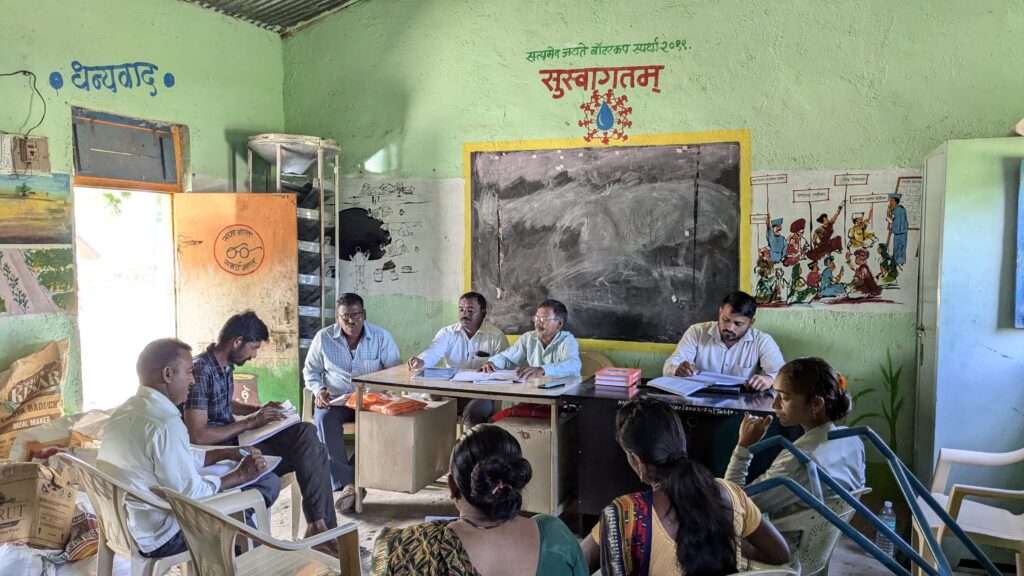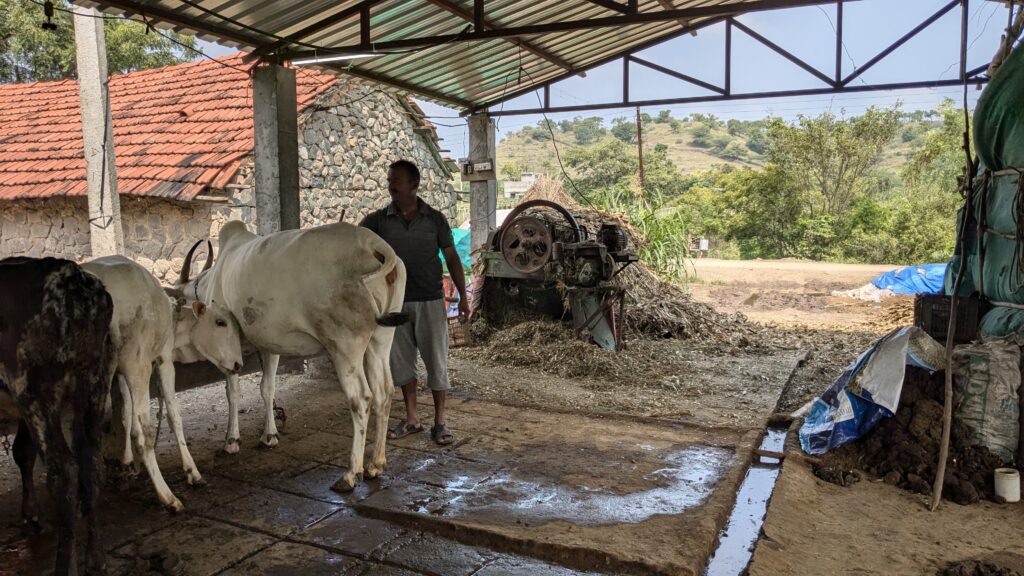Kumbharwadi might be a nondescript village in the Ahmadnagar district of Maharashtra, but look more closely and you’ll see it is a unique petri dish for experiments in natural farming (NF). Farmers with no institutional degrees or even formal education to their credit are testing, designing and implementing new techniques of natural farming in their battle for survival.
Ravindra Subhash Ugale worked as a wireman at a sugar factory until last year when he was laid off. The uncertainty compelled him to think of alternative ways to earn his livelihood and secure his future. That’s when he learnt about the concept of natural farming and enrolled in the 2023 NF batch in his village and attended the weekly Farmers Feed School. Then interactions with agricultural community resource persons (CRP) further led him to deliberate about the importance of health and the agricultural practices one must follow to lead healthy lives.

Currently, Ugale practices natural farming on his 4.5 acre land and aspires to become a full-fledged farmer. “I’m practicing multiple NF methods like mix-cropping and inter-cropping. I’m also developing my skills in animal husbandry,” says Ugale.
Also read: This Maha farmer banks on rare seeds for a sustainable future
Healthy crops, healthy tummy
Life has drastically changed for him and his family since they became wary of the health risks from exposure to fertilisers and pesticides, never mind the importance of health and eating well. “Our kitchen garden is thriving. We no longer need to buy vegetables from the market. In fact, we sell the excess and make a profit. The bio-gas set-up installed on my farmland has also made my family completely self-sufficient in terms of cooking gas.”
Other farmers in the village have also come to see not just the long-term consequences of chemical-based farming, but the disadvantages of hybrid seeds and the scarcity of water.
“Our health is closely connected to the health of the land. Prolonged use of chemical fertilizers, insecticides, and pesticides had worsened the health of our land. We had been following the rotational cropping pattern for the last couple of decades, but NF has changed our approach and attitude for the better,” says Bhagwat Ghagre, a farmer and also the secretary of Kumbharwadi’s Village Development Committee (VDC).
Tilling the land becomes attractive again
“I’ve 12.5 acres of land. I used NF on one acre by intercropping bajra (pearl millet) during kharif season and jowar (sorghum) and kardayi (safflower) during the rabi season. NF helped me save 80 percent of the expenses,” shares Ramesh Hundare, a farmer.
The 39-year-old dropped out of school early on, only to continue his formal education with the NF manual and practices. He now wants to shift to NF completely. “The VDC and CRP have taught me how to make bio-resources like jivamrut and dashparrni at home. I have hens, goats, cows and bulls. Now I am learning the ropes of animal husbandry and livestock farming,” shares Hundare.
Also read: Faith in the long game of natural farming

Encouraged by the results of NF, even the teenagers in the village – who used to be disillusioned by the idea of farming – now want to become farmers in the future.
Hundare’s son, Samarth, is a grade 11 student who now wants to pursue agricultural studies in college. “I want to learn about the modern agricultural technological methods that are practised across the world.”
The word spreads
The slow and secure methods of NF became a hot topic of discussion in nearby villages too.
“Farmers have a sharp eye when it comes to crops. The results are evident in the appearance of the products. NF products are better than the conventional ones. People from nearby villages often stop by and enquire about the NF method. It’s really fulfilling,” shares Asha Choudhary, a CRP.
By participating in various NF activities, several dozen farmers are now aspiring to become advanced farmers by adopting the complete integrated farming system.
“It keeps you engaged and always turns out to be a great learning experience. The best part is that all the activities can be carried out on the farm land simultaneously,” says Bhagwat Ghaghre who has adopted most methods of the integrated farming system. He started with livestock management and later began producing natural fertilisers, spray medicines, sea-bead extracts, micro-nutrients, sanjeevak (immunity booster), and plant promoters.
Not just that. Ghagre is even involved in reviving extinct plants, preparing vermicompost and establishing biogas units.

NF reduces input cost of cultivation and is more financially rewarding than chemical-based farming methods. Gokul Pawde, a farmer, used to grow makka (maize) on half a bigha of land and earn Rs 8000. Now, embracing one of the NF tenants of multicropping he grows 22 vegetables. “The model generates money consistently and has helped me earn Rs 20,000,” he says.
The seed of change
It was only in 2023 when these seeds of change were planted by the JIVA programme, an initiative by National Bank of Agriculture and Rural Development (NABARD) that is supported by Deutsche Gesellschaft für Internationale Zusammenarbeit (GIZ) GmbH, and implemented by WOTR. As a part of this 40 families in the village were chosen to participate in a pilot project. The next year twice as many participants joined the project.
It is only a matter of time the natural farming revolution sweeps across the country. The government recently launched the National Mission on Natural Farming (NMNF) promoting natural farming across India. Over the next two years, the mission will be implemented in 15,000 gram panchayat clusters – but it’s hoped one crore farmers will start NF across 7.5 lakh hectares.
Kumbharwadi is showing that it’s possible.
Also read: How an Andhra woman inspired her village to adopt natural farming
The lead image shows a community resource person guiding a farmer on the broad bed and furrow system, a technique for soil erosion control and moisture conservation. (Photo by Pranay Tripathi)
Pranay is an Indore-based filmmaker whose lens is always in search of how we ought to live. He is also a journalist, activist and nature-lover.
Please note: This story has been updated to include the local project partner.








